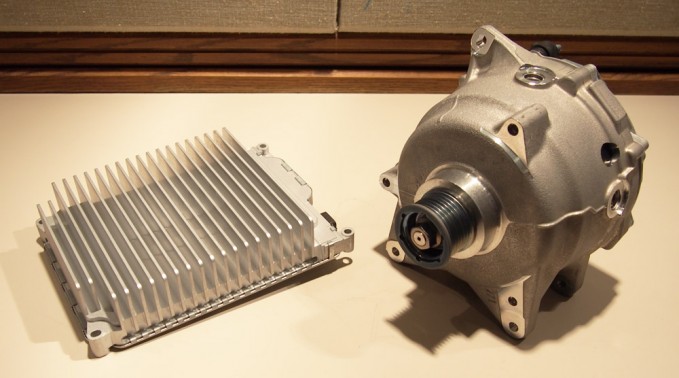Vehicles equipped with more powerful 48-volt electrical systems will start hitting the road in significant quantities in the near future. This shift will increase fuel efficiency considerably without breaking the bank.
Today’s automotive electrical systems operate on just 12 volts, a technological standard that’s been widely used in America since roughly the 1960s. But German supply juggernaut Continental has been hard at work on a new system with four times the juice.
This upgrade enables a surfeit of new technologies that are simply out of reach for today’s overtaxed electrical systems. With things like power windows, back-up cameras, adaptive cruise control and all the sensors that power these features, 12-volt technology has been pushed to its limit.
Why 48 Volts?
But by employing auxiliary 48-volt electrical systems, automakers can implement a wide range of fuel-saving features. Aside from enabling mild-hybrid functionality including stop/start and regenerative braking, this technology also allows for something known as “sailing,” which is cruising at a steady speed with the engine off.
Beyond all of these benefits, 48-volt systems could permit OEMs to easily add electrically operated oil, water and air-conditioning pumps, which would further curb consumption. In addition to this, they could also add electric catalyst heaters, which increase efficiency by getting the after-treatment system up to operating temperature in an instant so the engine doesn’t have to run an overly rich fuel mixture at start-up.
SEE ALSO: Continental Unveils Anti Road-Departure System
The main selling point of Continental’s 48-volt Eco Drive system is the ability to provide appreciably greater efficiency without the cost or complexity of a full hybridized drivetrain, but packaging is another benefit. Dr. Bernd Mahr, executive vice president of the firm’s electric vehicle business unit, said this technology is “easy to fit in a standard vehicle” because of the minimal number of components required. This means automakers could retrofit it into existing products without much trouble or easily incorporate it into new vehicle programs.
Integrating 48-volt technology is a snap because there are just three major parts necessary to make it all work. These include a small battery pack, a DC-to-DC power converter and an integrated starter/generator, which can be driven via a belt at the front of the engine or even engineered to mount in the vehicle’s transmission.
Additionally, “That second battery could easily be fitted under the seat … it’s a relatively small battery,” said Mahr, measuring just 0.4 or 0.5 kWh, though it could be larger. For 48-volt applications, lithium-ion chemistry is probably the best solution.
Yet another benefit of this technology is that automakers can use smaller-diameter electrical cables because as voltage increases, amperage can be decreased. This saves both money and mass, as unnecessary copper wiring adds weight and cost.
With all this talk of new electrical technology, it’s important to note the 12-volt system is not going away; it’s still in place to operate all of the remaining vehicle systems, from climate control and power windows, to the engine control system and radio.
SEE ALSO: Driving the Future with Continental
In a specially modified Ford Focus hatchback, Continental engineers were able to increase fuel efficiency by a whopping 17 percent on the New European Driving Cycle test regimen. That’s a huge increase, and the real-world results promise to be even more impressive. Additionally, their enhancements made this car compliant with super-stringent Euro 6c emissions regulations. It’s emits fewer than 95 grams of CO2 per kilometer.
Market Availability
Mahr said the cost for a complete 48-volt electrical system is in the neighborhood of 800 to 1,000 Euros, which makes them quite affordable for automakers to implement, “And that’s without government support,” he added. In some places hybrids and EVs receive subsidies to help them sell.
Continental’s 48-volt system will reach the European market late next year. Thanks to this technology’s copious benefits, the company already has six automakers signed up, with many more likely to follow suit. In fact demand, is so strong they’re expanding production to keep up. “It’s a steep ramp up,” said Mahr, a happy problem to have.










